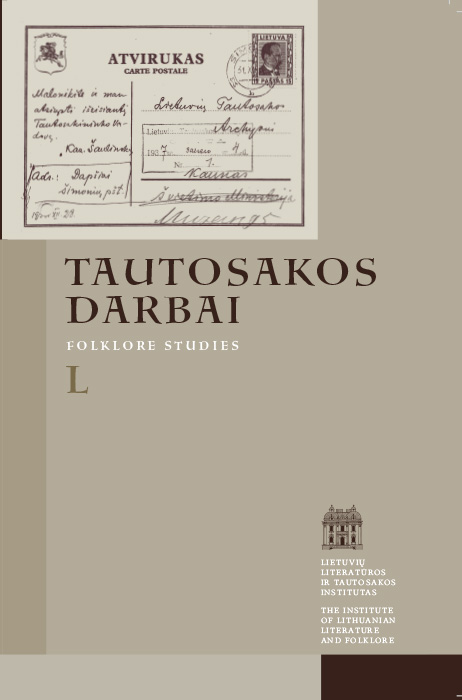Still Waters: Symbolism of the Image in Lithuanian and Slavic Paremias
Abstract
The aim of the article is discussing the peculiar image of still waters encountered in paremias: its origins, spread, formation of connotations, and its symbolism, with special emphasis on the differences in Lithuanian and Russian (and other Slavic) languages. The global type Still waters are / run deep / deepest or have a deep bottom emerged already in antiquity, based on a literary image, and subsequently spread across the whole of Europe. Proverbs belonging to this type in Lithuanian, Russian, Polish, and Latin are analyzed here with regard to their structure and semantics. The still waters symbolically describe a certain mode of human behavior or a characteristic complex of human features. The metaphoric transformation of meaning is based on an important peculiarity of water: its ambivalence, since a still or quietly running river can quickly turn into a dangerous and destructive force. The proverbial images tend to abstract these characteristics and by way of association transfer them to a social level: a quiet, equable person is usually wise, deep feeling, but under certain circumstances, he / she can surprise others with dauntless behavior. In Slavic languages, the negative connotation of the image in question has developed, still waters having come to symbolize feigned modesty and covert intrigues (or persons behaving that way). With time, the negative connotation became so pervasive, that with the standard text of the proverb shortened, it turned into a phraseological unit popular in many Slavic languages: Russian, Belorussian, Ukrainian, Polish, Bulgarian, and Serbo-Croatian.
Apparently, in Lithuanian language the negative connotation of the image in question did not develop due to existing synonymous proverb of an identical syntactic type Tyli kiaulė gilią šaknį knisa [‘A quiet pig roots up a deep root’], which used to be uttered in similar situations as proverbs with the still waters image. Whenever resentment against the selfish or treacherous behavior of the community members had to be vented, Lithuanians found the proverb mentioning the cunning, roguish pig to be more appropriate and expressive.
In the second half of the article, two texts characterized by archaic poetical structure are taken into consideration: namely, a Lithuanian verbal charm and a popular Russian proverbial phrase actively used until nowadays. In their imagery, two equivalent parts of the syntactic parallelism are brought together, i.e. the [still] waters and the [low] grass. They reflect but a single side of the ambivalent water image, symbolizing quietness, indulgency, peacefulness, and weakness. The author of the article assumes that in the Slavic languages the verbal charm could have existed as well, since the absence of Christian elements testifies to its archaism. The dictionary by Vladimir Dal contains a longer version of the Russian text with the verb in imperative still preserved, which completely corresponds to the Lithuanian charm. Therefore, it is quite possible that the verbal charming formula having cut adrift from the ritual, the conditions of its use have also changed and the transformation of the genre occurred: the same text continued existing according to the principles of a different genre, acquiring status of another folklore item (i.e. the proverbial phrase).
The established symbolic meaning of the image in question fits smoothly within the mythic symbolism of water as determined by other kinds of folklore (songs, tales, and legends), enriching it with peculiar qualities. It establishes a vivid and accurate parallel with characteristic human behavior and certain peculiarities of human character, and surprises us with variety of changing connotations inherent in the phrase itself.
Downloads
Most read articles by the same author(s)
- Giedrė Bufienė, Proverbs from Childhood: International Research of Children’s Speech and Thinking in the 20th Century , Tautosakos darbai: Vol. 51 (2016)
- Giedrė Bufienė, The Knight of the Proverbial Land , Tautosakos darbai: Vol. 47 (2014)
- Giedrė Bufienė, The Friends’ Gift to Arvo Krikmann , Tautosakos darbai: Vol. 48 (2014)
